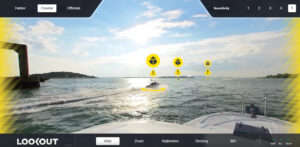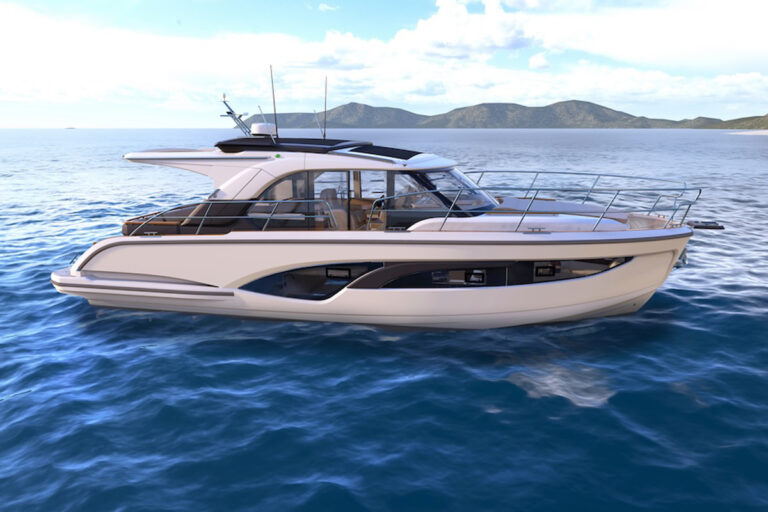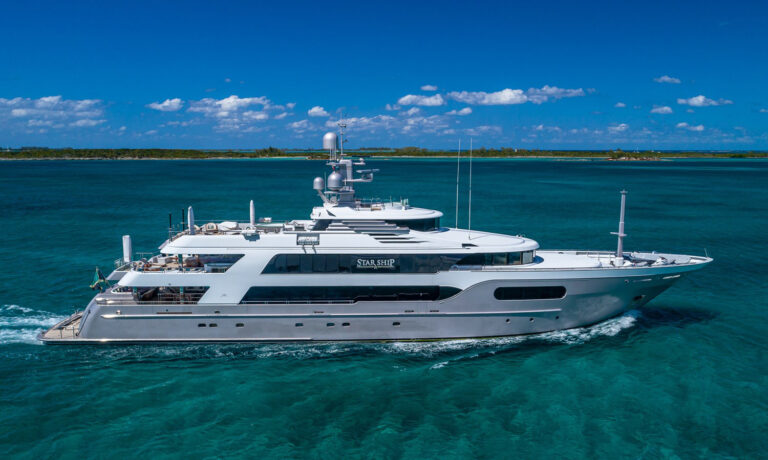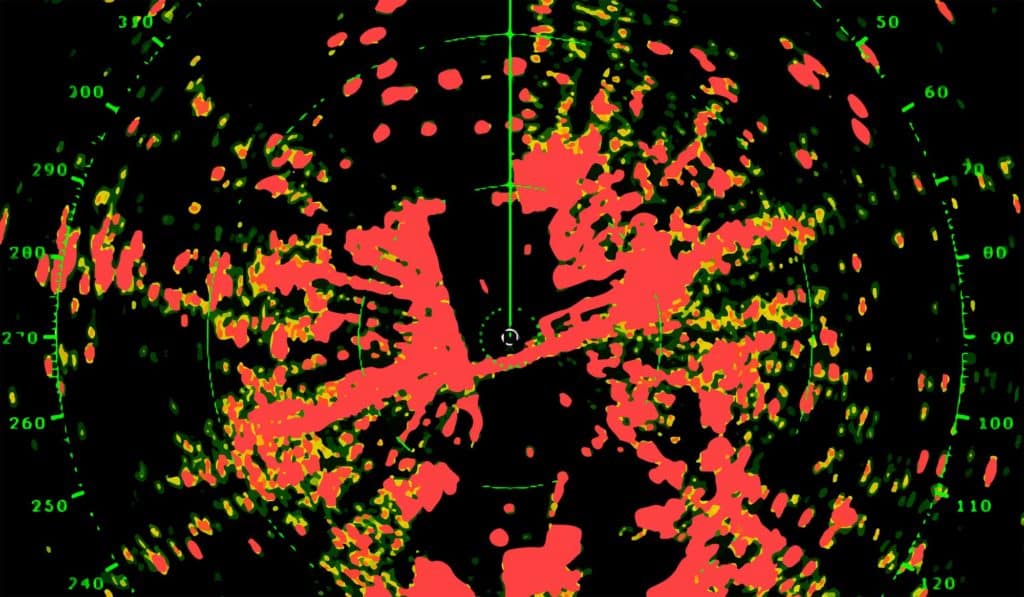
Red-green colorblindness carries significant disadvantages for yachtsmen. I, for one, have always struggled to identify navigation lights. Take the night that our crew was approaching the western entrance to the Strait of Juan de Fuca aboard a J/160. The horizon was a confusing scene of lit-up squid boats and sailboat-crushing container ships. While we had a full crew and a navigator to provide situational awareness, the waterway would have been a visual nightmare had I been alone.
Fortunately, today’s top-end radars employ solid-state power amplifiers — not cavity magnetrons — that facilitate Doppler processing and boost collision-avoidance tools.
Furuno made headlines in 2016 when it introduced the first radome-enclosed, Doppler-enabled, solid-state radar. The 25-watt DRS4D-NXT employs a 24-inch antenna, transmitting on X-band frequencies (7.0 to 11.2 GHz). It also uses Furuno’s Doppler processing (dubbed Target Analyzer) to differentiate nonthreatening targets (green) from dangerous ones (red).
This past fall, Furuno introduced its DRS6A-NXT open-array, Doppler-enabled, solid-state radar ($6,230 to $7,075). It’s available with 3.5-, 4- or 6-foot antenna lengths, with longer antennas delivering narrower beam widths and better target separation. Each DRS6A-NXT unit has 25 watts of transmitting power and Target Analyzer, as well as Fast Target Tracking (which displays target-vector information and triggers alarms) and a built-in automatic radar plotting aid (ARPA).
“ARPA starts tracking targets independently of Doppler,” says Eric Kunz, Furuno USA’s senior product manager. “It’s pretty foolproof.”
While X-band radars reflect rain well, the DRS6A-NXT units differentiate rain from other targets while showing hard targets inside of rain squalls.
Kunz says these Doppler-enhanced capabilities make solid-state radars better for navigation than magnetron radars. However, he noted that, for anglers, magnetron radars will continue to outshine solid-state radars at spotting distant birds (until solid state’s power output is enhanced).
Garmin also earned international attention in 2016 when it introduced the GMR Fantom 4 and GMR Fantom 6 radars — the recreational-marine market’s first Doppler-enabled, open-array radars. The 40-watt Fantoms were available with 4- or 6-foot antennas that delivered ranges of 20 feet to 72 nautical miles. They also used MotionScope technology (Garmin’s Doppler processing), which graphically differentiates dangerous targets from nonthreatening ones in user-selectable color palettes.
A few months later, Garmin released two radome-enclosed, solid-state, Doppler-enabled radars: the GMR Fantom 18 and GMR Fantom 24. Each delivers 40 watts of transmitting power and ranges of 20 feet to 48 nautical miles, with MotionScope technology and Garmin’s Auto Bird Gain, Dual Range, Dynamic Auto Gain and Echo Trails, which are also on the open-array Fantoms.
Now the Kansas-based technology giant has delivered newly redesigned (all-new hardware and software), higher-power Fantom radars dubbed the 54, 56, 124 and 126 ($5,999 to $8,499), available with 4- or 6-foot antennas and boasting substantially higher output power than their first-generation cousins. At the time of this writing, they are the most powerful solid-state, open-array radars available.
“The extra power lets you see birds,” says Dave Dunn, Garmin’s director of sales and marketing for marine, adding that the new Fantoms also have higher-resolution imagery and longer-range performance than their predecessors. Going forward, Garmin plans to release two lower-cost open-array Fantoms, each with 50 watts of transmitting power.
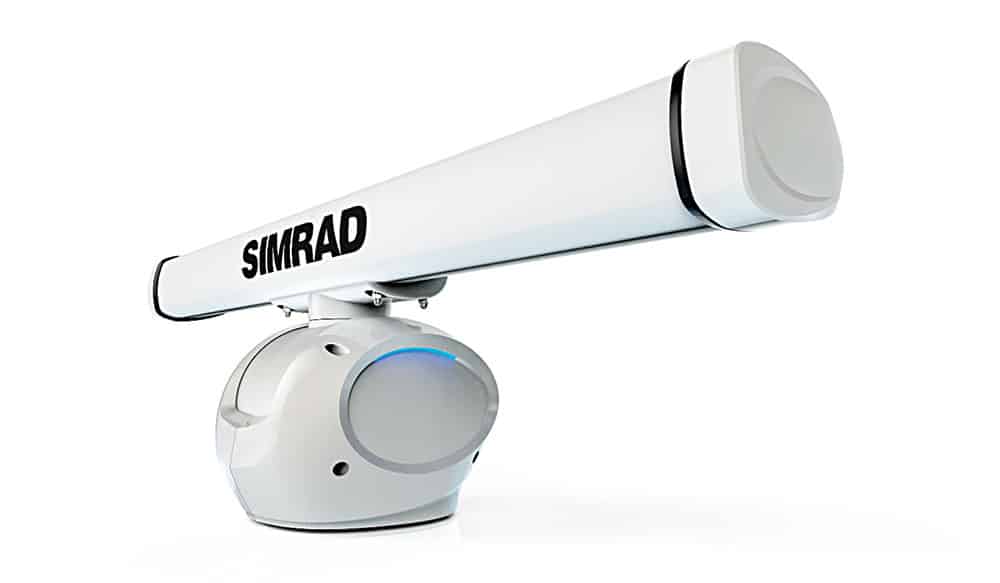
Raymarine introduced its Quantum Chirp solid-state radars in early 2016, but these radome-enclosed systems lacked Doppler processing. Instead, the 20-watt Q24C and the Wi-Fi-only Q24W use chirp pulse-compression technology to help separate targets across ranges from 18 feet to 24 nautical miles.
Raymarine has now released its Q24D radar ($1,999), leveraging Doppler processing and offset color palettes to differentiate targets based on threat levels. The Q24D also allows users to engage Raymarine’s Relative Motion True Trails, which puts trails on moving targets to help depict their direction of travel relative to one’s vessel.
Traditional radar “isn’t intuitive,” says Adam Murphy, Raymarine’s global product manager, adding that the Q24D will share the same power and specs as the existing Quantum radars. “We think Doppler will give users an extra boost of confidence.”
The Q24D also has a mini automatic radar plotting aid, allowing users to select 10 targets for the radar to track, separate from its Doppler capabilities. Additionally, “the radar automatically tracks dangerous targets,” says Murphy, adding that future-generation Quantum radars will have ARPA capabilities. “It was a hardware hurdle to get Doppler processing, but now it’s a software hurdle moving forward.”
Murphy says Raymarine may roll out an open-array Quantum based on demand: “We’ll see how the market progresses, but we won’t be releasing a ‘me-too’ product.”
Simrad released its Halo open-array radars in 2015, becoming the first recreational marine manufacturer to use a solid-state gallium-nitride power amplifier to transmit on X-band frequencies. These radars didn’t offer Doppler processing; instead the original 25-watt Halo-3, Halo-4 and Halo-6 radars used pulse compression coupled with Simrad’s beam-sharpening technology. The company is allowing customers to upgrade new or existing Halo radars with an unlockable Doppler-processing software called VelocityTrack ($500), which lets Halo radars graphically differentiate dangerous targets from benign returns.
“We made sure that we had ‘no compromise’ when Doppler was activated,” says Mark Harnett, Simrad’s recreational-radar product manager, adding that VelocityTrack limits antenna rotation to 24 rpm but doesn’t affect the radar’s transmission scheme or signal processing. “Dual range is also unaffected, so you can use Halo with VelocityTrack turned on or off and be confident [that] core radar functionality is performing optimally,” says Harnett.
Simrad’s VelocityTrack, like the Garmin version of the feature, is friendly to those who struggle with red-green colorblindness.
“You can choose any of our existing color palettes,” Harnett says. “Approaching targets are either yellow or red, depending on the palette you choose; diverging targets are always a blue-gray color.”
Whatever Doppler-radar technology you choose, one thing is certain: Seeing is relieving.




